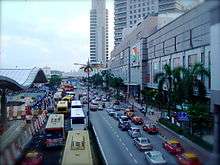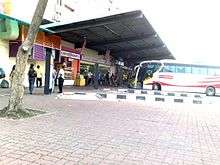Iskandar Malaysia
| Iskandar Malaysia (إسکندر مليسيا) | ||
| Development Corridor | ||
|
||
| Country | Malaysia | |
|---|---|---|
| State | Johor | |
| Region | Johor Bahru District Kulai District Pontian District (South) | |
| Population | 1.805 million[1] (2013) | |
| Timezone | Malaysian Standard Time (UTC+8) | |
| - summer (DST) | not applicable | |
| Postcode | 79xxx-82xxx | |
| Area code | +607 | |
Iskandar Malaysia (IM; Jawi: إسکندر مليسيا), formerly known as Iskandar Development Region (IDR; Malay: Wilayah Pembangunan Iskandar; Jawi: ولايه ڤمباڠونن إسکندر) and South Johor Economic Region (SJER), is the main southern development corridor in Johor, Malaysia. It was established on 8 November 2006.[2] The project is administered by Iskandar Regional Development Authority (IRDA) and was named after the 24th Sultan of Johor and the 4th Sultan of modern Johor, Almarhum Sultan Iskandar ibni Almarhum Sultan Ismail.[3]
History

The special economic zone of Iskandar Malaysia grew out of a 2005 government requested feasibility study by the Khazanah Nasional which found that the development of such a zone would be economically, socially and developmentally beneficial.[4] The National SJER Planning Committee (NSPC), hearing Khazanah's findings, put it in charge of developing a sustainable, holistic approach to development in the region.[4] Iskandar Malaysia was singled out as among the high-impact developments of the Ninth Malaysia Plan, put into action by the then Prime Minister of Malaysia (Abdullah Badawi) in March 2006 to cover the period of 2006 to 2010.[5] In November 2006, the Prime Minister, Chief Minister of Johor, Abdul Ghani Othman and Khazanah revealed the Comprehensive Development Plan (CDP).
In 2014, Malaysian Prime Minister Najib Razak announced that “In committed investments alone, the economic zone in Johor has secured RM156.51 billion (US$47 billion) since 2006, of which 51 per cent or RM79.17 billion (US$23.8 billion) has been realised to date.” The amount is around 41% of the target amount, which Iskandar Malaysia seeks to achieve by 2025.[6]
Scope
The development region encompasses an area of 2,217 km2 covering Johor Bahru District, Kulai District, Pekan Nanas and Kukup. Five local government authorities have jurisdiction over the covered area, including Johor Bahru City Council, Iskandar Puteri City Council, Pasir Gudang Municipal Council, Kulai Municipal Council and Pontian District Council.
The population of Iskandar Malaysia was 1.8 million in 2010, rising from 1.3 million in 2000.[7] The region is has a workforce of 0.62 million in 2005. The GDP per capita (PPP) of the region is $14,790 in 2005, with an annual growth of around 6%.[8]
Comprehensive Development Plan
Flagship Zones
Under the plan, five "Flagship Zones" in the 221,634.1 hectares (2,216.3 km²) of land covered are identified as developmental focal points.[3][9] Four of these Flagship Zones are found in the "Special Economic Corridor" (SEC) of Iskandar Puteri-Johor Bahru-Pasir Gudang. The corridor—which includes the significant ports of Tanjung Pelepas, Pasir Gudang and Tanjung Langsat— is prioritised for development in the Comprehensive Development Plan (CDP), with particular focus on Iskandar Puteri. The CDP originally included "Free Access Zones", but these were dropped from the plan in 2007.[10]
Johor Bahru City Centre is Flagship Zone A, including development of a new financial district, the central business district, the waterfront city of Danga Bay, a mixed development in Tebrau Plentong and the area near Wong Ah Fook Street.
Flagship Zone B is Iskandar Puteri, with planned development of the Kota Iskandar, Medini Iskandar Malaysia, a medical hub, EduCity, a resort for international tourism and an industrial logistic cluster and residences.
Flagship Zone C, the Western Gate Development, focuses on the Port of Tanjung Pelepas (PTP), Malaysia–Singapore Second Link, a free trade zone, the RAMSAR World Heritage Park and the Tanjung Piai.
Flagship Zone D, the Eastern Gate Development, focuses on the Pasir Gudang Port and industrial zone, Tanjung Langsat Port, the Tanjung Langsat Technology Park and the Kim-Kim regional distribution centre. In the final Flagship Zone, Senai-Skudai, development is focused on the Senai International Airport, hubs for cargo and knowledge, a multimodal centre and the MSC Cyberport city.
Economic growth
The economic growth plan of the CDP consists of two components, a Strategic Economic Thrust (SET) for immediate implementation and a Future Growth Scenario, 2005-2025, for long-term application. Both of these were developed in mind of the region's economic strengths in manufacturing and services, with 60% of value-added manufacturing derived from electrical and electronic (E&E), chemical and chemical products (petrochemical, plastics, oleo chemicals) and food processing sub-sectors. A number of service and other manufacturing areas have emerged in support of these. The SET focuses on such factors as strengthening existing economic sectors and encouraging diversity, through incentives, stronger international ties, and proper allocation of resources and space. The Future Growth Scenario is aimed towards strengthening the economy internally and internationally by such factors as improvements in global transportation and developing manufacturing and service clusters. Also promoted by the Future Growth Scenario is the encouragement of the immigration of skilled, monied foreigners to help develop an international lifestyle attractive to foreign workers and investors.[11]
The presence of foreign companies were also significant,[12][13] with Singapore being the largest investor in Iskandar Malaysia followed by the United States, Spain, Japan and China as of September 2014.[14]
Residential enhancement
Part of the CDP includes attention to quality of life of residents with emphasis on functional, liveable communities that promote social wellbeing. Among the components of this plan are factors designed to integrate various members of society into a cohesive whole while also ensuring that the needs and wishes of special populations are met, such as reducing marginalisation by mixed-cost housing communities, promotion of a sense of communal belonging, ensuring that adequate rental homes are provided for transient populations, monitoring the housing requirements of those with special needs, and ensuring that accessible housing is available to the disabled. Residential plans also include guiding residential development to minimise crime and maximise energy efficiency, through the application of Crime Prevention through Environmental Design (CPTED) guidelines and the implementation of a "Green Building" rating.
Physical Development Plan
The Physical Development Plan (PDP) was designed to guide the development of land within Iskandar Malaysia to help promote the CDP's overall goals of economic development and quality of life. To that end, the CDP includes two major subdivisions among land zones, "Basic Zoning Districts" and "Special Overlay Zones".
There are several dozen primary "Basic Zoning Districts" governing the use of land in commercial, residential, industrial and other sectors, including determining the density of development and what mixed use may or may not be allowed.[10] Also governed by the "Basic Zoning Districts" are such special use zones as green space, wetlands, cemeteries and governmental developments.
"Special Overlay Zones" are areas that require exceptional treatment. For example, the "Johor Bahru CBD" allows exceptions to general commercial plot ratio and height because the zone is the commercial and financial centre of Iskandar Malaysia and the capital city of Johor. Similarly, the "Iskandar Puteri Central Planning Area" is given special handling. Other "Special Overlay Zones" cover environmentally sensitive areas, historic areas, coastland, development around highways and rail stations and the "Water Catchment Zone" around the Sultan Iskandar Dam.
Commercial Development
The commercial focus of the CDP is on six services identified as "pillars", including creative, educational, financial, healthcare, logistics and tourism. The CDP included the establishment of the Iskandar Investment Berhad (formerly the South Johor Investment Corporation Berhad), a commercial investment holding company created to oversee and encourage regional development.[15] The CDP promotes the "Strategic Catalyst Development" goals of developing waterfront areas, promoting tourism, expanding healthcare and iconic areas, and mixing commercial and residential development.
It also incorporates a "Business Incentives and Support Package" (ISP) discussed by Prime Minister Badawi on 22 March 2007 which allows special incentives to encourage investment in certain concentrated hubs in the flagship zones. The specific zones involved were revealed in October 2007 and at that time included only Medini Iskandar Malaysia, which is a mixed-development zone incorporating leisure, residential, financial and high-end industrial components. Incentives include tax exemptions for qualifying companies for income from qualifying activities,[16] exemption from Foreign Investment Committee rules, and flexibilities under the foreign exchange administration rules, including those restricting the numbers of "foreign knowledge workers".
Major Projects 2006-2025
- Iskandar Coastal Highway
- Johor Bahru East Coast Highway
- Johor Bahru Eastern Dispersal Link Expressway
- Johor Premium Outlets
- Kota Iskandar
- Larkin Sentral
- Legoland Malaysia Resort
- Senai–Desaru Expressway
- Asia Petroleum Hub
- Tanjung Bin
- Southern Gateway CIQ
- Iskandar Puteri HSR
- Johor Bahru–Singapore Rapid Transit System
- RAPID Pengerang Refinery
- Forest City
- Princess Cove
- Ibrahim International Business District IIBD
- Desaru Coast
- Puteri Harbour
- Iskandar Sentral
- Southkey Mall
- Gerbang Nusajaya
- Educity
Transportation
Land

The internal roads linking different parts of the region are mostly federal roads constructed and maintained by Malaysian Public Works Department. The five major highways linking the Johor Bahru Central Business District to outlying suburbs are Tebrau Highway and Johor Bahru Eastern Dispersal Link Expressway in the northeast, Skudai Highway in the northwest, Iskandar Coastal Highway in the west and Johor Bahru East Coast Highway in the east.[17] Pasir Gudang Highway and the connecting Johor Bahru Parkway cross Tebrau Highway and Skudai Highway, which serve as the middle ring road of the metropolitan area. The Johor Bahru Inner Ring Road, which connects with the Sultan Iskandar customs complex, aids in controlling the traffic in and around the central business district.[17] Access to the national expressway is provided through the North–South Expressway and Senai–Desaru Expressway. The Johor–Singapore Causeway links the city to Woodlands, Singapore with a six-lane road and a railway line terminating at the Southern Integrated Gateway.[17] The Malaysia–Singapore Second Link, located west of the metropolitan area, was constructed in 1997 to alleviate congestion on the Causeway. It is linked directly to the Second Link Expressway, Johor Bahru Parkway, the railway station, and the North–South Expressway.[18] Further expansion of other major highways in the city were currently in the process.[19]
Public transportation
Larkin Sentral, located 5 kilometres northwest of the city centre has direct bus services to and from many destinations in West Malaysia, southern Thailand and Singapore.[20] Two types of taxis operate in the city; the main taxi is either in red and yellow, blue, green or red while the larger, less common type is known as a limousine taxi, which is more comfortable but expensive.[21] Since 2014, various taxi-booking applications have begun in the city such as Uber,[22] and GrabTaxi.[23] The Johor Bahru Sentral railway station serves train services to Kuala Lumpur and Singapore.[24] In 2015, a new shuttle train service operated by Keretapi Tanah Melayu (KTM) was launched providing transport to Woodlands in Singapore.[25]
Air
The region is served by Senai International Airport which is located in Senai.[18] Five airlines, AirAsia, Firefly, Malaysia Airlines, Malindo Air and Xpress Air, provide flights internationally and domestically.[26]
Sea
Johor Port is located in the eastern part of Iskandar Malaysia in the industrial area of Pasir Gudang. It is a seaport for commodities and mineral resources seaport, as Johor is home to a large number of major commercial plantations. The port is also the location of the majority of Malaysia's resources refineries.[27] In the west side of Iskandar Malaysia, the Port of Tanjung Pelepas, which ranks as Malaysia’s largest container port since 2004 is ranked as the 19th busiest container port in the world as of 2013. Boat services are also available to ports in Sumatra.[18]
See also
References
- ↑ "Iskandar Malaysia Key Economic Statistics". Iskandar Regional Development Authority. Iskandar Malaysia. Archived from the original on 2 December 2014. Retrieved 26 July 2015.
- ↑ New township planned for Malaysia's Iskandar economic zone, Richard High, 4 July 2008, KHL Group
- 1 2 WPI kini Iskandar Malaysia, (Muka Hadapan), 11 April 2006, Utusan Malaysia
- 1 2 Iskandar Regional Development Authority & Iskandar Malaysia Information Pack, 23 February 2007, Khazanah Nasional, pg 3, retrieved 3 March 2009
- ↑ Rancangan Malaysia Kesembilan, Ministry of Information Malaysia, retrieved 4 March 2009
- ↑ "Establishment Post". Archived from the original on 7 January 2015. Retrieved 8 February 2015.
- ↑ "IskandarMalaysia". Retrieved 8 February 2015.
- ↑ "IskandarMalaysia economy.pdf" (PDF). Archived from the original (PDF) on 8 February 2015. Retrieved 8 February 2015.
- ↑ Iskandar Regional Development Authority & Iskandar Malaysia Information Pack, 23 February 2007, Khazanah Nasional, pg 9, 13, retrieved 3 March 2009
- 1 2 Free Access Zone under IDR scrapped, MEERA VIJAYAN, 5 April 2007, The Star (Malaysia)
- ↑ IDR not exempted from foreign workers ratio, Farik Zolkepli, 20 November 2007, The Star (Malaysia)
- ↑ Karen Chiu; Grace Cao (5 December 2013). "Chinese investors home in on buoyant Malaysia". The Standard. Archived from the original on 26 July 2015. Retrieved 26 July 2015.
- ↑ Vivien Teu (12 February 2014). "China developers target Johor Bahru". Perspectives. Archived from the original on 26 July 2015. Retrieved 26 July 2015.
- ↑ "Iskandar Malaysia Records RM158.13 billion in Investments For Year 2014". Iskandar Regional Development Authority. Iskandar Malaysia. 10 March 2015. Archived from the original on 26 July 2015. Retrieved 26 July 2015.
- ↑ Iskandar Regional Development Authority & Iskandar Malaysia Information Pack, 23 February 2007, Khazanah Nasional, pg 4, retrieved 3 March 2009
- ↑ IRDA Announces 10 Year Tax Relief For Developers In Node 1 of Iskandar Development Region, Iskandar Malaysia, 9 October 2007, Malaysia
- 1 2 3 "Flagship A: Johor Bahru City". Iskandar Regional Development Authority. Iskandar Malaysia. Archived from the original on 27 July 2015. Retrieved 27 July 2015.
- 1 2 3 Simon Richmond; Damian Harper (December 2006). Malaysia, Singapore & Brunei. Ediz. Inglese. Lonely Planet. pp. 247–253. ISBN 978-1-74059-708-1.
- ↑ "Chapter 15: Urban Linkage System (Section B: Planning and Implementation)" (PDF). Iskandar Malaysia. Archived from the original (PDF) on 28 July 2015. Retrieved 28 July 2015.
- ↑ "Larkin Bus Terminal". Express Bus Malaysia. Archived from the original on 28 July 2015. Retrieved 29 July 2015.
- ↑ "Johor Bahru Taxi". Taxi Johor Bahru. Archived from the original on 20 August 2015. Retrieved 20 August 2015.
- ↑ Daniel Tay (22 August 2014). "Uber secretly arrives in Johor Bahru with free rides in hand". Tech in Asia. Archived from the original on 20 August 2015. Retrieved 20 August 2015.
- ↑ Steven Loeb (1 July 2015). "GrabTaxi raises $200M, now valued at $1.5B". Vator. Archived from the original on 20 August 2015. Retrieved 20 August 2015.
- ↑ "From Singapore to KL by train". The Malaysia Site. Archived from the original on 28 July 2015. Retrieved 29 July 2015.
- ↑ "Singapore to Malaysia in just 5 minutes? It's now possible". The Straits Times/Asia News Network. Philippine Daily Inquirer. 5 July 2015. Archived from the original on 20 August 2015. Retrieved 20 August 2015.
- ↑ "Malaysia's new airline in $1.5bn deal with Bombardier". BBC News. 18 March 2015. Retrieved 17 August 2015.
- ↑ "Profit From Malaysia's Petrochemical Industry (Pasir Gudang-Tanjung Langsat, Johor)" (PDF). Malaysian Industrial Development Authority. 2011. p. 6. Archived from the original (PDF) on 29 July 2015. Retrieved 29 July 2015.


